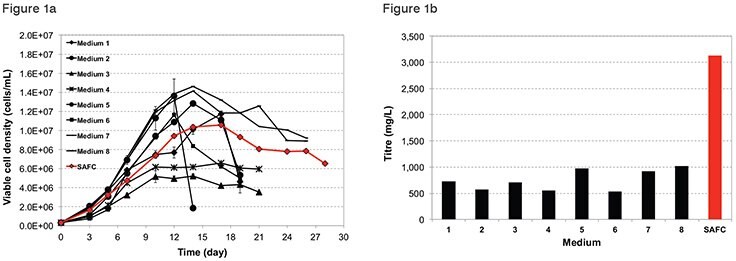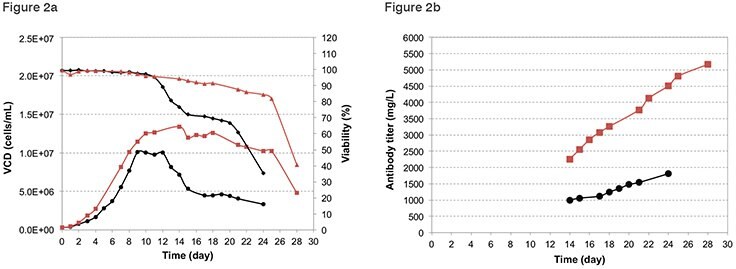EX-CELL® Advanced™ CHO Fed-Batch System – Bioprocessing Technology Institute, Singapore Case Study
Introduction
In mammalian cell culture, culture biomass and protein production are largely dependent on the cell line and media used. In this study, nine commercially available, chemically defined media and feed combinations from different vendors were assessed for producing monoclonal antibody in Chinese hamster ovary (CHO) cells. The influence of each medium on cell growth and antibody production was evaluated in fed-batch shake flask cultures. Top media were further evaluated in 2 L fed-batch bioreactors. A desired titer of >5 g/L was obtained by using the best performing commercial medium without any optimizations. These results demonstrate the potential of commercially available fed-batch systems to achieve high titer in early bioprocess development and expedite time to market.
Experimental Method
Cell Line and Inoculum Expansion
A CHO DG44 cell line expressing a monoclonal IgG was used as a model cell line. The cells were thawed and propagated in Lonza’s PowerCHO™ 2 Chemically Defined, Serum-free CHO Media supplemented with 6 mM L-glutamine. In routine culture, cells were inoculated at a cell concentration of 3×105 cells/mL, using a working volume of 30 mL in 125 mL Erlenmeyer shake flasks (Corning). Cultures were grown at 37 °C, 140 rpm, 5 % CO2, and 80 % humidity from vial thaw and expanded in shake flasks at increased volume. The commercially available media products that were investigated are shown in Table 1.
Fed-batch Cultures
Cells were adapted to each medium before being evaluated by passaging over two weeks until viability recovers beyond 95%. Fed-batch cultures were grown in 125 mL Erlenmeyer shake flasks (Corning) at a starting volume of 30 mL. The inoculum concentration was 3×105 cells/mL applying the same culture conditions as described for seed train cultures. All fed-batch cultures were run in triplicates with feeding regimens as recommended per respective product information sheets. Feed media were reconstituted from powder and were sterilely filtered through a 0.22 μm filter. In all fed-batch experiments, a concentrated glucose solution (250 g/L) was used to maintain the concentration of this nutrient above 3 g/L. Cultures were terminated once the viability dropped below 60%.
Cell Culture Analysis
Viable cell density (VCD) and viability were measured using Vicell systems (Beckman Coulter). The concentrations of key metabolites (i.e., glucose, glutamine, lactate, and ammonium) were determined using a BioProfile™ 100 Plus (Nova Biomedical). Recombinant antibody concentration was determined by using a nephelometric method on an IMMAGE 800 immunochemistry system (Beckman Coulter, Buckinghamshire, England).
Bioreactor Operations
2 L glass bioreactors (Sartorius Stedim) were used in confirmation and further optimization. Bioreactors were inoculated in the range of 0.3–0.5×106 cells/mL and bolus fed according to Table 2 for ~21 day cultivation. Dissolved oxygen (DO) was controlled at 50% using pure oxygen. pH was controlled using CO2 and 1N NaOH.
Results: Shaker Flask
In fed-batch experiments, the impact of the culture medium on cell growth and antibody concentrations, as well as the process duration, was evaluated. The differences in vendor composition of basal media and feeds had a substantial effect on peak cell concentrations and antibody titers (as shown in Figure 1a, b).

In general, high cell concentrations, > 10×106 cells/mL, correlated well with high titers. The highest product concentration of 3.1 g/L was achieved in cultures grown in the chemically defined Ex-Cell Advanced CHO Fed-batch Media supplemented with Ex-Cell Advanced Feed 1. Fed-batch cultures grown in all other commercially available media and feed combinations achieved 3-fold less of the peak product concentration observed with the Ex-Cell Advanced CHO Fed-batch System.
Results: Bioreactor
The PowerCHO™ 2 and Ex-Cell® Advanced™ media and their corresponding feeds (Table 2) were then evaluated for cell growth and antibody production at 2L bioreactor scale (as shown in Figure 2a, b). Yeast hydrolysates were added in Xtreme™ to boost titer in PowerCHO 2 medium. Cultures grown in the chemically defined Ex-Cell Advanced CHO Fed-batch System demonstrated sustained biomass, high viability and high product production rates after achieving peak viable cell densities. This is compared to a 50% reduction in biomass with cultures grown in PowerCHO 2 and supplemented with Xtreme. In addition, fed-batch cultures grown in PowerCHO 2 and supplemented with Xtreme achieved 44% or less of the peak product concentration observed with the Ex-Cell
Advanced CHO Fed-batch System.

Conclusion
Cultures grown in the chemically defined Ex-Cell Advanced CHO Fed-batch System demonstrated > 2 - fold higher product production over 9 commercially available, chemically defined Chinese hamster ovary (CHO) cell culture media from different vendors. Fed-batch experiments demonstrated the beneficial effect of tailored feeds to off-the-shelf commercial media.
如要继续阅读,请登录或创建帐户。
暂无帐户?